
Leucopogon is a genus of about 150-160 species of shrubs or small trees in the family Ericaceae, in the section of that family formerly treated as the separate family Epacridaceae. They are native to Australia, New Zealand, New Caledonia, the western Pacific Islands and Malaysia, with the greatest species diversity in southeastern Australia. Plants in this genus have leaves with a few more or less parallel veins, and tube-shaped flowers usually with a white beard inside.

Leucopogon parviflorus, commonly known as coast beard-heath or native currant, is a shrub or small tree in the family Ericaceae. It is native to Australia and New Zealand.
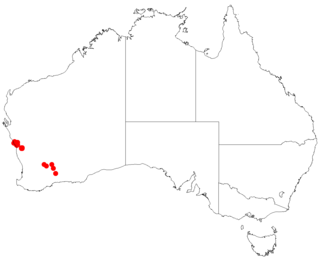
Styphelia marginata is a shrub in the family Ericaceae native to Western Australia. It was first described as Leucopogon marginatus by W. Fitzgerald in 1904. Until 2020, the accepted name continued to be Leucopogon marginatus. However in 2020, with a publication concerning the phylogeny of Styphelia by Crayn and others, the name Styphelia marginata was accepted by the Herbarium of Western Australia.

Astroloma foliosum, commonly known as candle cranberry, is a small shrub species in the family Ericaceae. It is endemic to the Perth region in Western Australia.
Persoonia leucopogon is a species of flowering plant in the family Proteaceae and is endemic to Western Australia. It is an erect to low-lying shrub with branchlets that are densely hairy when young, narrow oblong to narrow elliptic leaves and yellow or greenish yellow flowers borne singly or in groups of up to four on a rachis up to 2 mm (0.079 in) long.
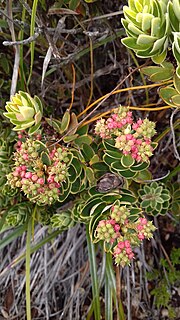
Cyathopsis is a genus of shrubs in the family Ericaceae. The genus is endemic to New Caledonia in the Pacific and contains three species that have previously been included in Styphelia. It is related to genera such as Leucopogon, Lissanthe and Styphelia.
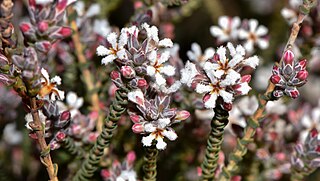
Leucopogon sprengelioides is an erect shrub in the family Ericaceae found in Western Australia, where it grows on granite outcrops and hill, ridges and breakaways and on coastal limestone. It grows to a height of 0.2 - 0.8 m and its white flowers may be seen from March to April or July to November.

Leucopogon pulchellus, commonly known as coast beard-heath, is a shrub in the family Ericaceae, native to the south west of Western Australia. It grows to heights between 15 cm and 1.5 m, generally on lateritic or granitic soils, and its white flowers may be seen from June or November or from January to February.

Leucopogon plumuliflorus is a shrub in the family Ericaceae. It is endemic to Western Australia.

Leucopogon pendulus is a shrub in the family Ericaceae. It is native to Western Australia.
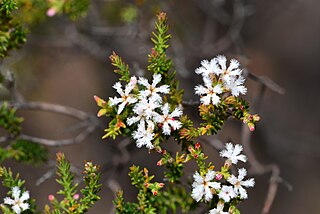
Leucopogon gracillimus is a shrub in the family Ericaceae. It is native to Western Australia.
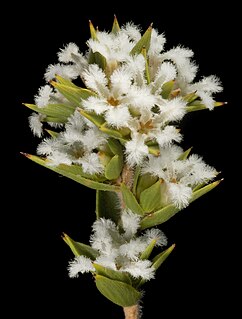
Leucopogon oliganthus is a shrub in the family Ericaceae found in Western Australia.

Leucopogon gracilis is a shrub in the family Ericaceae found in Western Australia.

Styphelia planifolia is a small shrub in the family Ericaceae native to Western Australia. It was first described as Leucopogon planifolius in 1845 by Otto Wilhelm Sonder, but moved to the genus,Styphelia, by Hermann Sleumer in 1963. Until 2020, the name Leucopogon planifolius was the name accepted by the Council of Heads of Australasian Herbaria, but the Herbarium of Western Australia now accepts the name Styphelia planifolia based on the phylogenetic studies of Crayn and others.
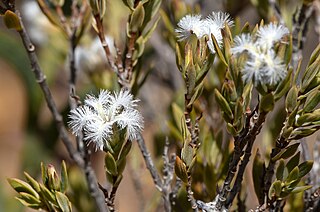
Leucopogon foliosus is a plant in the family Ericaceae native to Western Australia. It was first described in 2016 by Michael Hislop. The species epithet, foliosus describes the leafy inflorescence.
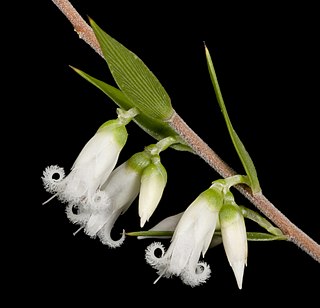
Styphelia conostephioides is a plant in the family Ericaceae native to Western Australia. It was first described in 1839 as Leucopogon conostephioides by Augustin Pyramus de Candolle. In 1867 Ferdinand von Mueller transferred it to the genus, Styphelia, but the accepted name continued to be Leucopogon conostephioides. However in 2020, with a publication concerning the phylogeny of Styphelia by Crayn and others, the name Styphelia conostephioides was accepted by the Herbarium of Western Australia.

Leucopogon gibbosus is a small plant in the family Ericaceae, endemic to Western Australia. It is an erect shrub, growing from 0.2 m to 1 m high, on sandy soils often over granite or on lateric gravel. Its white flowers may be seen from February to October.
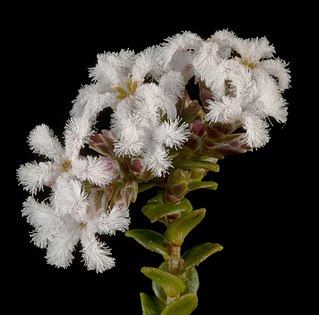
Leucopogon cordatus is a small plant in the family Ericaceae, endemic to Western Australia. It is an erect spreading shrub, growing from 0.35 m to 1 m high, on sandy soils often over granite laterite or limestone. Its white flowers may be seen from July to November.

Leucopogon oldfieldii is a small plant in the family Ericaceae, endemic to Western Australia. It is an erect spreading shrub, growing from 0.22 m to 1 m high, on sands, on sandplains. Its white-pink flowers may be seen from June to September.

Leucopogon polymorphus is a small plant in the family Ericaceae, endemic to Western Australia. It is a shrub, growing from 0.2 m to 1 m high, on sandy soils. Its white flowers may be seen from June to October.



















